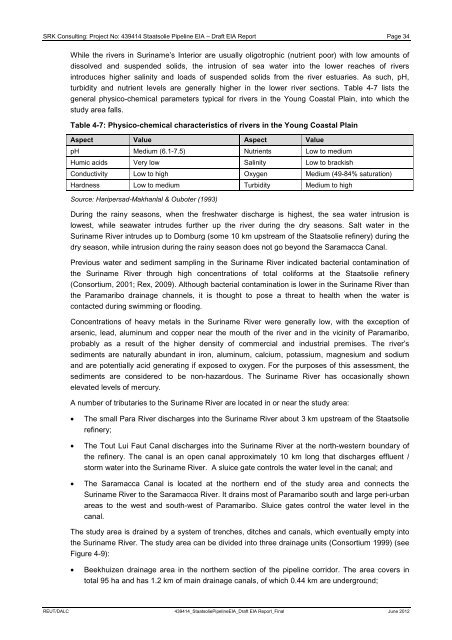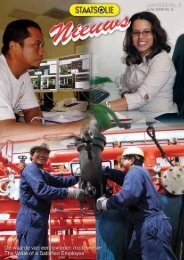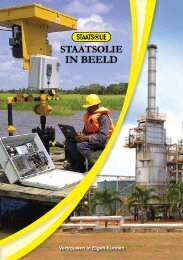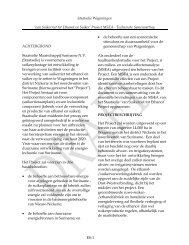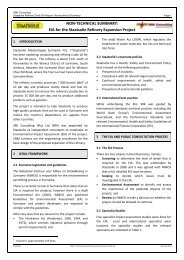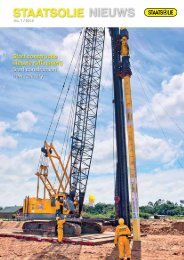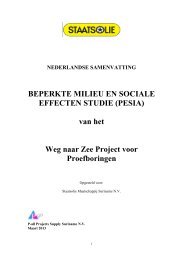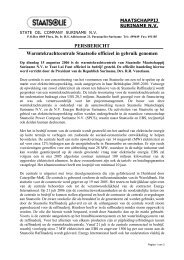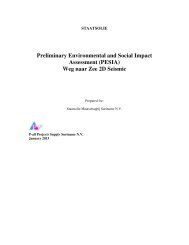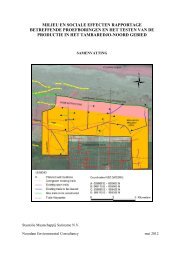concept EIA-rapport - Staatsolie
concept EIA-rapport - Staatsolie
concept EIA-rapport - Staatsolie
Create successful ePaper yourself
Turn your PDF publications into a flip-book with our unique Google optimized e-Paper software.
SRK Consulting: Project No: 439414 <strong>Staatsolie</strong> Pipeline <strong>EIA</strong> – Draft <strong>EIA</strong> Report Page 34<br />
While the rivers in Suriname’s Interior are usually oligotrophic (nutrient poor) with low amounts of<br />
dissolved and suspended solids, the intrusion of sea water into the lower reaches of rivers<br />
introduces higher salinity and loads of suspended solids from the river estuaries. As such, pH,<br />
turbidity and nutrient levels are generally higher in the lower river sections. Table 4-7 lists the<br />
general physico-chemical parameters typical for rivers in the Young Coastal Plain, into which the<br />
study area falls.<br />
Table 4-7: Physico-chemical characteristics of rivers in the Young Coastal Plain<br />
Aspect Value Aspect Value<br />
pH Medium (6.1-7.5) Nutrients Low to medium<br />
Humic acids Very low Salinity Low to brackish<br />
Conductivity Low to high Oxygen Medium (49-84% saturation)<br />
Hardness Low to medium Turbidity Medium to high<br />
Source: Haripersad-Makhanlal & Ouboter (1993)<br />
During the rainy seasons, when the freshwater discharge is highest, the sea water intrusion is<br />
lowest, while seawater intrudes further up the river during the dry seasons. Salt water in the<br />
Suriname River intrudes up to Domburg (some 10 km upstream of the <strong>Staatsolie</strong> refinery) during the<br />
dry season, while intrusion during the rainy season does not go beyond the Saramacca Canal.<br />
Previous water and sediment sampling in the Suriname River indicated bacterial contamination of<br />
the Suriname River through high concentrations of total coliforms at the <strong>Staatsolie</strong> refinery<br />
(Consortium, 2001; Rex, 2009). Although bacterial contamination is lower in the Suriname River than<br />
the Paramaribo drainage channels, it is thought to pose a threat to health when the water is<br />
contacted during swimming or flooding.<br />
Concentrations of heavy metals in the Suriname River were generally low, with the exception of<br />
arsenic, lead, aluminum and copper near the mouth of the river and in the vicinity of Paramaribo,<br />
probably as a result of the higher density of commercial and industrial premises. The river’s<br />
sediments are naturally abundant in iron, aluminum, calcium, potassium, magnesium and sodium<br />
and are potentially acid generating if exposed to oxygen. For the purposes of this assessment, the<br />
sediments are considered to be non-hazardous. The Suriname River has occasionally shown<br />
elevated levels of mercury.<br />
A number of tributaries to the Suriname River are located in or near the study area:<br />
• The small Para River discharges into the Suriname River about 3 km upstream of the <strong>Staatsolie</strong><br />
refinery;<br />
• The Tout Lui Faut Canal discharges into the Suriname River at the north-western boundary of<br />
the refinery. The canal is an open canal approximately 10 km long that discharges effluent /<br />
storm water into the Suriname River. A sluice gate controls the water level in the canal; and<br />
• The Saramacca Canal is located at the northern end of the study area and connects the<br />
Suriname River to the Saramacca River. It drains most of Paramaribo south and large peri-urban<br />
areas to the west and south-west of Paramaribo. Sluice gates control the water level in the<br />
canal.<br />
The study area is drained by a system of trenches, ditches and canals, which eventually empty into<br />
the Suriname River. The study area can be divided into three drainage units (Consortium 1999) (see<br />
Figure 4-9):<br />
• Beekhuizen drainage area in the northern section of the pipeline corridor. The area covers in<br />
total 95 ha and has 1.2 km of main drainage canals, of which 0.44 km are underground;<br />
REUT/DALC 439414_<strong>Staatsolie</strong>Pipeline<strong>EIA</strong>_Draft <strong>EIA</strong> Report_Final June 2012


